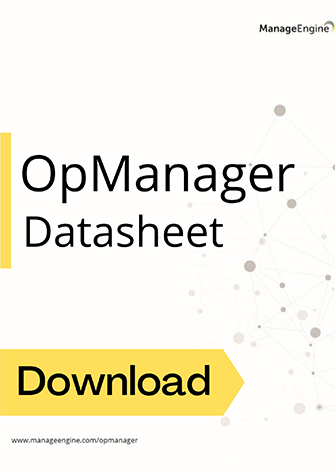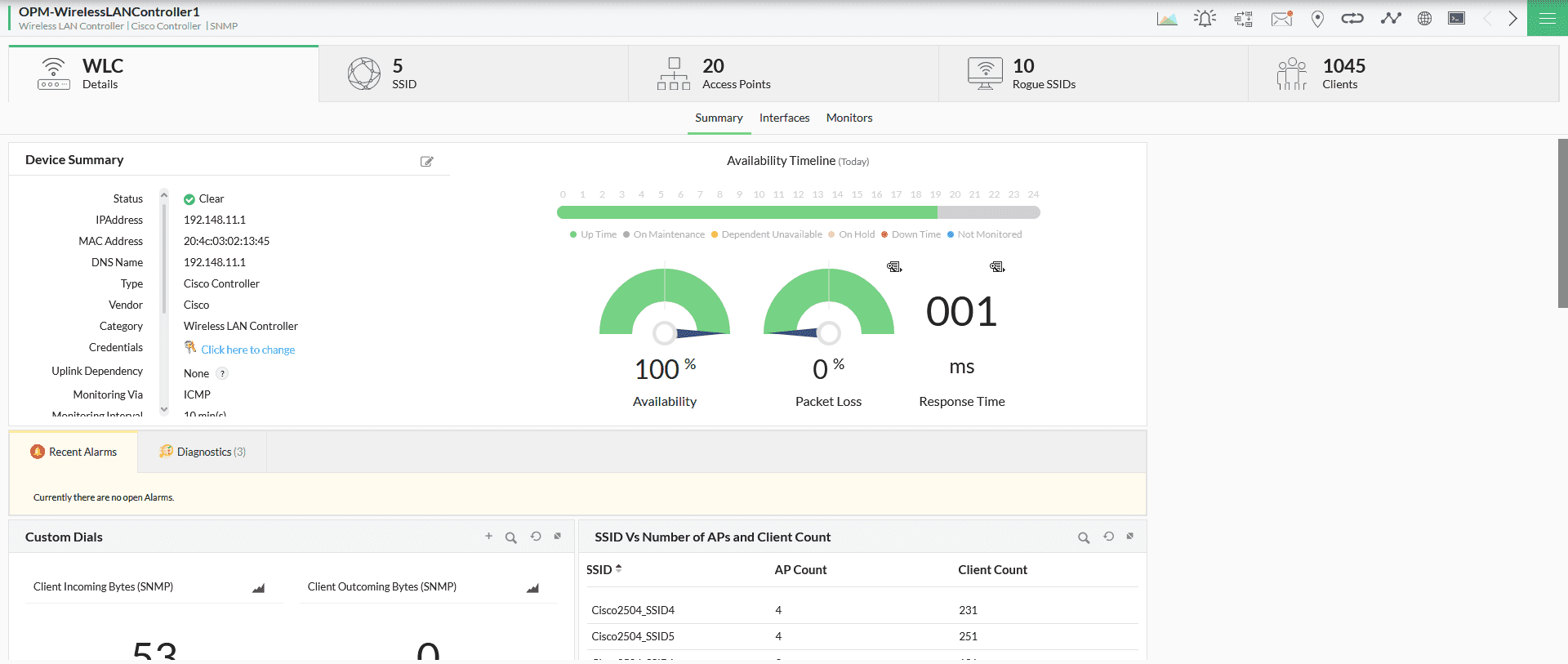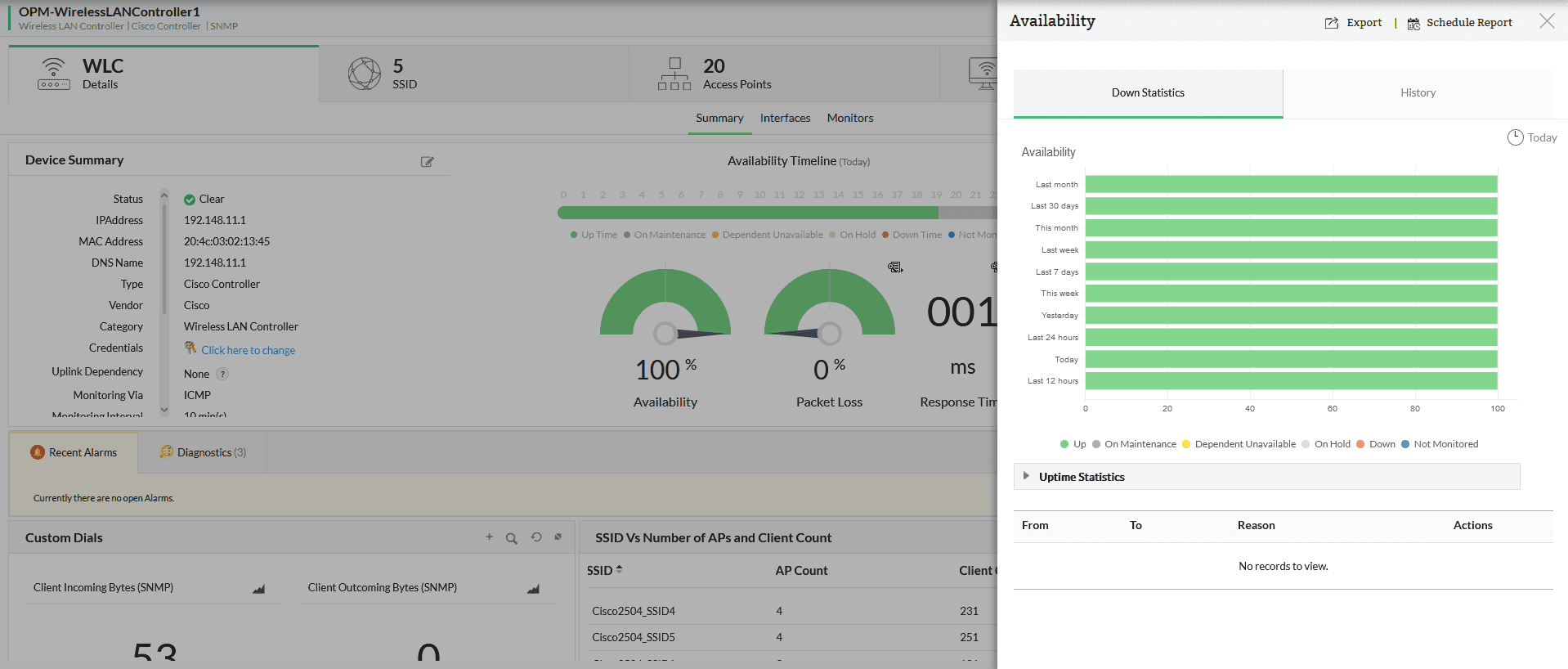 Learn more about OpManager's features & functions
Learn more about OpManager's features & functions
So what makes wireless networks the ubiquitous endpoints of modern networks? The simple answer is that they're convenient. They don't need cable management, you don't have to worry about ports, they occupy less space, and they afford more freedom to employees.
As simple and convenient as they are, you have to consider several factors to get the best out of your wireless networks. Various wireless network solutions are available for different challenges and use cases. For instance, the wireless network solution used for a large IT park with acres of land would be different from the one for a small office space in a downtown high-rise. Deploying the right solution gives you the best return on investment, and keeps your users happy and connected to the internet.
Before we explore wireless network solutions, let's refresh some basics.
Access points : Access points (APs) are the most important components of WiFI network solutions. They transmit and receive radio frequency information to set up a wireless local area network (WLAN). APs usually transmit data in two bandwidths: 2.4GHz and 5GHz. APs connect to a network router to provide internet connection. Some APs also have built-in routing capabilities.
Wireless LAN controllers : Wireless LAN controllers (WLCs) are used in certain wireless networks to control APs in bulk. You can use WLCs to manage network settings, set QoS metrics, configure security policies, and control the functionalities of hundreds of APs at the same time.
Client devices : Client devices connect to APs using network radios which can send and receive radio frequency waves. The client devices must authenticate themselves with the wireless network, usually using a password or pin to connect to the network. Client devices with malicious or unrecognized intent in a network are termed as rogue devices.
Network size plays a major role in determining the kind of wireless networking solution deployed in it . Small and medium-sized networks can have up to a thousand devices, while enterprise networks can have thousands of devices. APs deployed for each case is different.
Autonomous access points : On small and medium-sized networks, a low number of devices connected to the network lends itself to a lower amount of APs. In these setups, each AP would be an independent device which can be configured and monitored independently.
Lightweight access points : Once a network reaches a certain size, it becomes tough to configure each AP, one by one. There would be hundreds of APs for which you would need to configure security policies, set QoS metrics, and perform network monitoring. Lightweight APs are used for such networks. These APs are managed in bulk by a WLC.
Cloud-based access point management : Another way of managing the large number of APs in a large-sized network is by delegating AP management to the cloud. An example of this would be Cisco Meraki. The cloud server performs AP management while the lightweight APs handle real-time functionalities on the site.
APs must broadcast signals of uniform strength throughout the intended coverage area. Devices moving within the coverage area should have uninterrupted connections, especially for services like VoIP and high-quality video streaming. You should prioritize minimal interference and the elimination of dead zones.
Infrastructure mode : In the wireless infrastructure mode, wireless APs are connected to each other using cables. The cables form a wired higher-level network that allows LAN data sharing. APs share the same WLAN service and has smooth handover between APs.
AP mesh mode : Here the APs directly connect to each other and share information wirelessly. The bridging operations are conducted using some channels of the bandwidth. While this is very convenient due to the direct connections between the APs, it has to be noted that the bandwidth can become congested. APs also need extra processing power to perform this.
Ad hoc network : Ad hoc wireless networks are created using wireless devices like laptops and workstations. These are temporary networks created out of necessity and usually don't scale well for many devices.
Interference is caused by radio waves of similar frequencies distorting each other. Interference can be caused due to devices crowding a bandwidth channel, or due to noise from other devices like microwaves, cordless phones, and bluetooth devices which operate in the same bandwidth.
The 2.4GHz range is prone to interference as it has a fewer number of channels. Equipment like bluetooth speakers, cordless phones, and microwaves also operate in the same bandwidth and can interfere. The 5GHz range is less crowded, but it has limited range. WLCs and APs have built-in solutions for problems with interference and noise.
Wireless load balancing : WLCs can calculate the number of devices connected to APs. If this load is high, it can balance the load with other APs. Similarly, it can detect the power levels of APs that are interfering with each other adjust them to reduce interference.
Smart band select : This feature allows APs and WLCs to detect radio channel congestion and switch to less crowded bandwidths and channels. Most wireless devices are usually configured to the 2.4GHz, switching to the 5GHz band significantly reduces interference.
Privacy and security are particularly important for wireless networks, since any device within the range can connect to an access point. User authentication and data encryption protocols are implemented to prevent exploitation by bad actors.
WEP (Wired Equivalence Policy) and WPA (Wireless Protected Access) protocols were used in legacy models. These had limitations which made their usage redundant in later wireless networks. Newer wireless devices opt for the WPA2 and WPA3 protocols which have improved security features. It's imperative that you shift your wireless networks from WEP and WPA if you still use them. Currently, the safest protocol would be WPA3.
In a typical organization, there would be hundreds of types of devices connected to the network. There would be servers and databases storing critical information, as well as workstations, printers, desktops, and personal devices brought in by the employees. These devices would need differing degrees of permissions, priorities, and access.
For instance, the devices in the sales department should not be able to access the devices used by the finance team, and so on. If you intend to keep traffic within your network partitioned, you should consider wireless network solutions that allow the formation of virtual local area network, or VLAN.
Virtual local area network (VLAN) : VLANs allow local area networks to be partitioned logically. VLAN solutions are used by companies to operate devices on different networks while sharing the same LAN physically. Data packets are tagged so that only devices within the same VLAN can access that information.
We've covered the importance of wireless installations and how wireless network solutions are available for different scenarios. But that is only the beginning; once you deploy wireless networking solutions inside your network, you can't just hang up your boots and call it a day. You need proper visibility into the availability and performance of each device in that wireless network. That is where a comprehensive network monitoring tool like OpManager becomes relevant.
OpManager monitors all types of devices in your network and is available for small, medium, and enterprise-sized networks. You can add wireless devices to the device inventory in OpManager and monitor them the same way you monitor your servers, switches, and routers. OpManager provides deep visibility into network devices. For example, by discovering a WLC, you can discover and monitor all APs connected to it.
Let's see how OpManager improves your wireless installations.
It is convenient to have better visibility into device performance metrics as most network problems can be tracked down to these metrics. Access point CPUs perform the computations necessary for data transmission, reception, encryption, and decryption, along with other advanced functions.
When you enable mesh mode or built-in routing features in an access point, it can affect normal operations. Monitoring CPU utilization gives you an idea about how much the AP is strained. You can also monitor other performance metrics like memory and disk space.

You can monitor signal strength using metrics like signal to noise ratio (SNR) and channel noise value. OpManager can monitor SNR for client-AP connections as well as on the WLC end. Setting multi-level thresholds to notify you of increasing noise levels allows you to be proactive and fix the issues before they affect client devices.

OpManager lets you keep track of everything and everyone connected to your network. Inside a WLC device snapshot, you can view detailed accounts of APs, rogue devices, and the number of clients. Moreover, they can be monitored instantly by enabling advanced monitoring.

Get extensive visibility into wireless traffic utilization. For instance you can obtain the total received or transmitted byte count for clients, APs or WLANs as a whole. You can also monitor client transmit rates to gauge network performance.

Wireless network problems and solutions mean nothing if your devices experience downtime. OpManager's availability metrics keep track of device availability over time and generates reports for you to study them. Moreover it instantly notifies you about device unavailability through multiple channels like e-mail, SMS, Slack, webhooks, or push notifications in your phone.

OpManager also comes loaded with intelligent fault identification and resolution features which makes all the difference during an outage. In the event of a wireless network issues you have to sort through alerts, find the root cause of the issue, and then fix the issue. This can be a tough task, especially for larger networks.
OpManager's adaptive thresholds can automatically optimize threshold setting to best reflect network activity. This reduces alert floods and false positives. You can create a root cause analysis profile with up to 20 entities to correlate data and track down root cause when outages occur. OpManager also has an automated workflow feature that saves valuable time in performing first level troubleshooting tasks.
Whatever the issues in your wireless network solutions, OpManager is the one stop solution to monitor, alert, and resolve them. Download OpManager, the comprehensive WiFi networking solution or try our free 30-day trial to experience the difference.